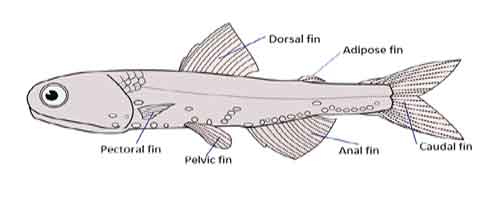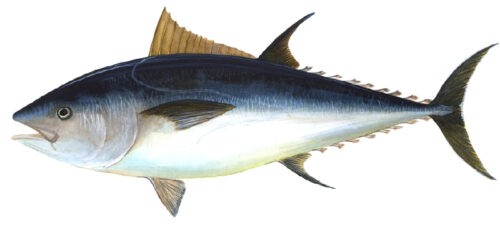Fish are cold-blooded aquatic vertebrate animals with torpedo shaped body. They have a wide variety of shapes, colors, and sizes. There are approximately 34,000 species of fish in the fresh and salt waters of the world.
Size Variations
There are numerous living fish species in the world. Among them, many fish are under a few cms in length at the adult stage. Dwarf pygmy goby (Pandaka pygmaea) is the smallest fish, of which, an adult male can grow up to 15 mm in length and adult female grows up to only 9 mm in length. But some fish species can grow tremendous sizes. Oarfish (Regalecus glesne) is the longest bony fish in the world which can reach up to 36 ft. (11 m) in length.
Some notable fish species and their length and weight are given in the following table
|
NAME OF FISH |
SCIENTIFIC NAME |
LENGTH |
WEIGHT |
WEIGHT |
|---|---|---|---|---|
|
Common ocean sunfish |
Mola mola |
up to 10.8 ft (3.3 m) |
up to 2,300 kg |
All warm and temperate seas |
|
Beluga sturgeon |
Huso huso |
up to 5 m (16.4 ft.) |
up to 2,000 kg |
The Caspian, Black, and Adriatic Seas |
|
Black marlin |
Makaira indica |
up to 15.4 ft (4.7 m) |
up to 750 kg |
South California to the Gulf of California to Chile. |
|
European wels catfish |
Silurus glanis |
up to 16.4 ft.(5 m) |
Up to 300 kg |
Caspian and Aral Sea basins |
The Appearance of the Body
The body shape of the bony fishes shows huge varieties. The typical fishes such as perches and basses have a compressed body, flattened from side to side. In others, such as carps and minnows, the body shape is elongated, usually with a rounded belly. In flatfishes like the soles and flounders, the body is depressed from top to bottom, while the other forms like the eels have an elongated and snake-like body.
Generally, fish show body shape in three ways: elongation, compression, and depression. A laterally compressed body shape is more common in bony fishes which dwell within coral reefs such as Butterflyfishes (Chaetodontidae) while depressed body shape is found in bottom-dwelling fishes such as Goosefishes (Lophidae) and batfishes (Ogcocephalidae). The elongated body shape is found in eels like the morays (Muraenidae).

The shape of the Head
The size of the head may be large, moderate and small. The head is covered on both sides by several bones such as the preopercle, opercle, interopercle and subopercle which together form the gill cover. Other parts of the head include the nostril, eye, chin, cheek, branchiostegal ray etc. The anterior part in the upper jaw of fish is known as premaxilla, the posterior one is known as maxilla while the lower jaw is known as mandible..
Scales
The body of the most bony fishes is covered with a layer of plates which are known as scales. It also acts as protected layers against predators. But some bony fishes may have scales only on portions of their body, and some species have no scales. The body of the most bony fishes is covered with cycloid or ctenoid scales.
Most bony fishes such as perches, basses, etc have tough, shingle-like scales with a comb-like or serrated edge along their rear margin, known as the ctenoid scale. Others fish like carps, barbs; minnows, etc have rounded scales with smooth edges along the rear margin, known as cycloid scale. Cycloid scales are smooth and circular in shape and they overlap the body from head to tail.
An outer layer of both cycloid and ctenoid scales consist of calcium and an inner layer of connective tissue. A characteristic toothed edge is present on the ctenoid scale. They are most common on fishes which have spiny fin rays. Scales of some fishes such as gars (family Lepisosteidae), bichirs, and reedfishes (family Polypteridae), are hard almost bony, fitting one against the other like the bricks on a wall. These are called ganoid scales. It has a layer of ganoin which is a hard, enamel-like substance. Ganoid scales are diamond-shaped, shiny, and hard. Some fishes do not have scales at all such as catfishes. Scales of the eels are widely separated and buried deep in the skin.
The placoid scale consists of a hard base embedded in the skin with a spiny process known as cusp and is a characteristics feature of the sharks.




Different types of fish scales
Body Spines and Rays
Some scales are modified to form body spines. Most of the bony fish have spines or rays. Generally, spines are inflexible, sharp and un-segmented while rays are flexible, segmented, and soft. Rays may be branched. The fish fin may contain only soft rays or only spiny rays or a combination of both. If fin contains both spiny rays and soft rays, the spiny rays are always located at the anterior position of the fin.
Generally, spines have various functions. In catfish, pectoral or dorsal fin bears spine which is used as a form of defense. Razor-sharp and mobile pre-caudal fin spines are found in most surgeonfishes (Acanthuridae) that they use it to protect themselves against predators. Some bony fishes such as pufferfishes (Tetraodontidae) have spines which cover the entire body to protect themselves against predators.
Fins
Fins are the most distinguishable characteristics of fish which help to identify the fish species. It is a thin component which composes of bony spines protruding from the body skin. Fins are located in different places of the body for serving various purposes. Swimming is the general function of fins. In fishes, fins are the following types:
Dorsal fins: This type of fin is located on the back of the fish. The fish uses it for locomotion and making a balance in the water during swimming. It also helps to defend the fish against rolling.
Caudal fins: It is also known as tail fin which is located at the end of the caudal peduncle. It is mainly used for forwarding movements. Caudal fins are of different types such as:

- Heterocercal: Found in sharks
- Protocercal: Found in cyclostomes and the living dipnoanst
- Diphycercal: Found in bichir, lamprey, coelacanth, and lungfish
- Homocercal: Found in most modern fishes. These types of fins have a variety of shapes such as:
- Rounded
- Truncated
- Forked
- Emerginate
- Lunate
- Double emerginate

Anal fin: It is positioned on the ventral (bottom) surface of the fish body just behind the anus. Fish use it for stability during swimming.
Pectoral fin: It is placed near the operculum on each side of the body homologous to the human arms.
Pelvic fin: It is a paired fin which is placed the ventral surface of the fish body homologous to the hind limbs of tetrapods. This type of fin makes force during swimming for going up and down in the water.
Adipose fin: It is a soft and fleshy type fish which is located behind the dorsal fin closer to the caudal fin. This type of fin helps the fish during navigation in rough water.
Mouth and its Position
The mouth has a different size and shapes. The position of the mouth varies in different species. A mouth opening straight with the snout projecting in front is known as terminal mouth. A mouth posterior to the tip of the snout is known as sub-terminal. A mouth positioned on the underside of the head with the snout projecting in front is known as inferior. A mouth that opens upward, with lower jaw more anterior than upper jaw is known as superior. Oblique mouths are characterized by the angle of the closed mouth which is about 45 0 or more when closed. Protracted mouths are those that are protrusible and are directed upwards or downwards. A ventral mouth is located entirely on the ventral side of the head.
The shape and size of the mouth is the good indicator of feeding habits of bony fishes. Generally, mouths of most of the bony fishes are positioned at the frontage end of the head. Mouths of some bottom-dwelling fishes are located on the underside position of the snout that is angled toward the bottom while some surface-feeding fishes have mouths that can angle upwards. The mouth of butterflyfishes (family Chaetodontidae) is small with thin snouts which are used for searching food in crevices and cracks. Some bony fishes have barbells around the mouth which help to detect food.




Image Showing Different Types of Mouth of Fish
Teeth
Tremendous diversity exists in the form and size of fish teeth. The character of dentition is dependent on the feeding habits of the fish. Some fishes have pointed-edged wounding teeth called incisors located in the forward part of the mouth. Some species possess sharp conical teeth known as canines. Many species have molariform teeth that can easily crunch organisms like mollusks, crustaceans, and other animals. Some fishes have villiform teeth that are slender and form velvety bands. Fishes like carps, minnows, and suckers have teeth in their throat. These teeth are known as pharyngeal teeth and are sharp in some, molariform in others. Some fishes have teeth on the roof of the mouth.



Different types of teeth of fish
Finlets
Finlets are modified small fins which look like ridges and they are located between the dorsal and the caudal fin or between the anal and the caudal fins. They are found in very fast swimming fish like tuna. It helps to increase the swimming speed of the fish, by cutting through the water.

Scutes
Scutes are enlarged bony dermal plates or scales usually associated with the lateral line or on the caudal peduncle or along with the ventral profile. Fishes of the family Clupeidae have a series of scutes along the abdomen. Generally, scales are modified and form sharp, protective plates or scutes. It acts as a body armor environmental abrasions and even predation.
Generally, scales on the caudal peduncle form scutes. Some fishes such as Jacks mackerel have a row of scutes along the lateral line on either side but an abdominal row of scutes are present on River herrings and threadfins. Body of the pinecone fish (Family Monocentridae) is completely or partially covered with scutes.


